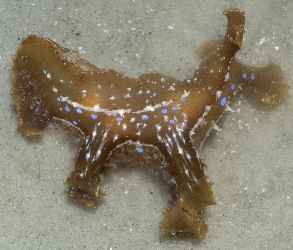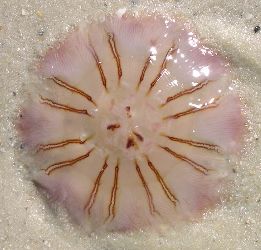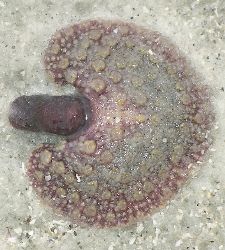 Nudibranch or Sea Slug |  Jellyfish |
 Sea Pansy |  Eel and Sea Shells |
Although most people think of shell collecting as the main goal of beachcombing, I've never felt limited to mollusk remains. I did have to learn what was acceptable to collect, since many fascinating items contained too much decaying flesh to be able to pack away during a long trip. It was obvious that things like jellyfish, squid, and sea cucumbers were way too mushy, while fish bones and teeth, bird feathers, sea biscuits (seeds), and fishing lures were usually just fine. There were surprises, though, such as the hermit crabs that stowed away deep inside of snail shells, only to die and begin their odiferous decomposition while packed deep inside a bucket of treasures hidden someplace in the trunk of our automobile. Many items were borderline; a seahorse, for example, if dried properly, was okay, but not a still moist cowfish. Starfish, sponges, sea urchins, and horseshoe crabs were only permissible if most of the soft tissues were washed away or dried completely.
While the desire to haul back beach finds has definitely diminished as I have aged, the attraction of all those cool creatures certainly has not. When I take a long beach walk, I now think about the amount of weight that I am carrying, however small it might be. I also don't have the room to store or display a large physical collection. And, truthfully, many of the most appealing things do not lend themselves to more than ephemeral enjoyment, as even the vivid colors of newly washed up seashells fade quickly when they are dried. If I find a creature that appears to be still healthy, I feel obligated to throw it back out into the water so it has a second chance. Many ocean creatures do not even have hard parts, so when they die there is not much left.
 Nudibranch or Sea Slug |  Jellyfish |
 Sea Pansy |  Eel and Sea Shells |
There is now an invaluable tool for the incurable beachcomber who nevertheless does not want to mess with, well, the mess. That boon is the digital camera. I tried in the past to take photos on the beach with my old film camera, but I've got to admit that it seemed a waste of film to photograph something just because I wanted to see it better or identify it later. Now that the ongoing cost of film is eliminated, there is no obstacle to snapping a picture of anything that grabs my fancy. The bright colors of algae, the curious look of a crab, the glassiness of a jellyfish; they are all just begging to be captured in pixels. Once the freedom of digital photography is embraced, it is easy to move from mere recording of found items to indulging in artistic license. The way several shells are juxtaposed, the patterns in the sand, and even the way the water washes over beach detritus are all subjects for an active imagination and a cheap digital camera.
There is one disadvantage to photographing on the beach and that is the salt spray. Anyone who wears glasses knows of this problem. In no time at all, any clear surface is coated with a foggy film that tends to smear instead of wipe off. With a little care, though, the camera lens can be kept clean enough. Sometimes it means facing away from the wind when possible, using one's body as a barrier. Days with little wind are of course better. However, I've even been out in gusty, rainy weather and still managed to photograph by using my poncho to shield the camera from the elements. It probably helps to have a small camera, as well as one that is not so precious that one fears for its exposure to wind, water, and sand.
Aside from a bit of concern over the condition of equipment that is used a lot on the beach, there is really no drawback to "collecting" with a camera. It doesn't matter if a subject is huge or tiny, dead and stinky or still alive, fragile or heavy. Capturing an image means the item can be left just as found, so the next beachcomber to come along can see it too. And the photos stored on a memory card will never smell up the car.